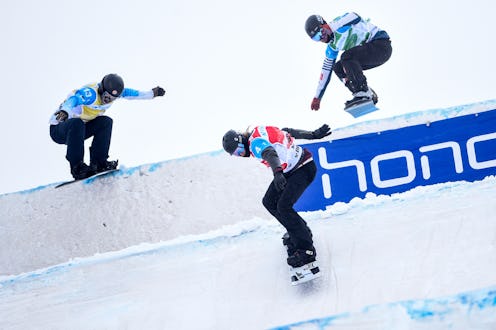News
Your Guide To Understanding What The Heck Snowboard Cross Is

From classic events to more recent sports, Olympics viewers are accustomed to watching downhill mountain athletes make their runs solo. Not so with snowboard cross (also known as boardercross), a fairly new Winter Games addition that puts up to six racers on the same course at the same time. Finishing first usually guarantees the gold, but a judge and jury score snowboard cross to ensure rule adherence, too. And considering the competitors' breakneck speed on their crowded mountain track, it's little wonder why.
Up to six riders at a time race down one hill that contains a series of jumps and turns. Because the race lasts less than one minute, boarders must maximize their speed from start to finish. Snowboard cross is kind of like the 100-meter dash of mountain sports — multiple competitors racing side-by-side on one very short course. But there is one key difference — snowboard cross racers have no set "lane." Once they're out of their starting gate, the entire course is open to everyone.
The top recorded speed for snowboard cross riders hit 60 mph. (Think about that next time you're on the freeway.) It helps explain why putting six snowboarders on a noticeably narrow track amounts to "45 seconds of downhill Darwinism," as Sports Illustrated's Austin Murphy aptly described the event. There's no time or space for mistakes, and riders are often in direct physical contact with each other.
Prior to the "Big Final" race, boarders will complete several "seeding" runs to determine their rank. The fastest competitors in each heat are given first choice for their preferred starting gate in the next race. Riders will all know which starting position — from outside to center — should best set them up for success. And with such a short race, any edge at all can go a long way towards earning the gold. So there are definitely perks to finishing well in early runs.
First-time viewers should note that each racer is assigned a bib color based on their respective heat rankings in the previous "seeding" runs. The fastest racer in each heat is assigned a red bib. Second-fastest wears green, the third-ranking gets blue, fourth wears yellow, fifth wears white, and the sixth ("slowest") racer gets a black bib. The race goes so fast and the riders are so close together that colored bibs are a huge help in tracking who's who down the course.
Intentional contact (i.e., pushing, shoving, etc.) is strictly prohibited in snowboard cross. The rules state that riders who do so will be disqualified. However, many veteran snowboard cross competitors all but admit that physical jostling is part of the game.
"It kind of becomes a free-for-all," said U.S. snowboarder Nate Holland, who goes on to describe the sport as "a mosh pit at 45 mph." In an NBC Olympics video, Holland proclaimed that if he gets "T-boned" on the slopes, he'll "put that guy into the fence." According to Holland, anyone who intentionally takes down another competitor becomes a "marked man."
"A little sharp elbow... I mean, see ya later, little kid," Holland said. The inclusion of intentional foul play in the sport is not even implied — in Holland's telling, such tactics are declared outright. Backing up this description, fellow U.S. snowboarder (and 2018 Olympics contender) Alex Deibold says that "you've gotta put your arms out" around turns not so much for balance, but to make sure "you don't get pushed out of the way."
Pushing and shoving may be formally against the rules. But it seems as though many riders think that if it's necessary to get ahead and they can get away with it, then they'll get physical.
But though the rider at the front of the pack can make his way downhill however he chooses, one thing he can't do is purposefully try to cut off another rider's route. That's against the rules.
If a rider thinks any of the rules have been violated during their run, they can report that to the "Chief of Finish" at the end of the race. The Chief of Finish will then report the complaint to the rest of the three-person jury, who must then decide whether or not to disqualify the accused. Riders who wish to report have to do so before the next heat of racers takes off.
Anyone who has watched a race will probably agree with legendary American snowboard cross athlete Lindsey Jacobellis, who describes the sport as "football and roller derby and motor cross all put together." And while not every race features a rider run-in, there's no doubt that snowboard cross can absolutely become a contact sport.
The speed and contact of the sport have led some to wonder if snowboard cross — with its lightning fast speed, crowded track, and multiple opportunities for collisions both accidental and intentional — is perhaps too dangerous for the Olympics. Justin Vanderleest notes at HuffPost that at the 2010 Vancouver Winter Games, a full 35 percent of ski and snowboard cross athletes were seriously injured in the course of competition.
But as of now, snowboard cross doesn't look like it's going anywhere.